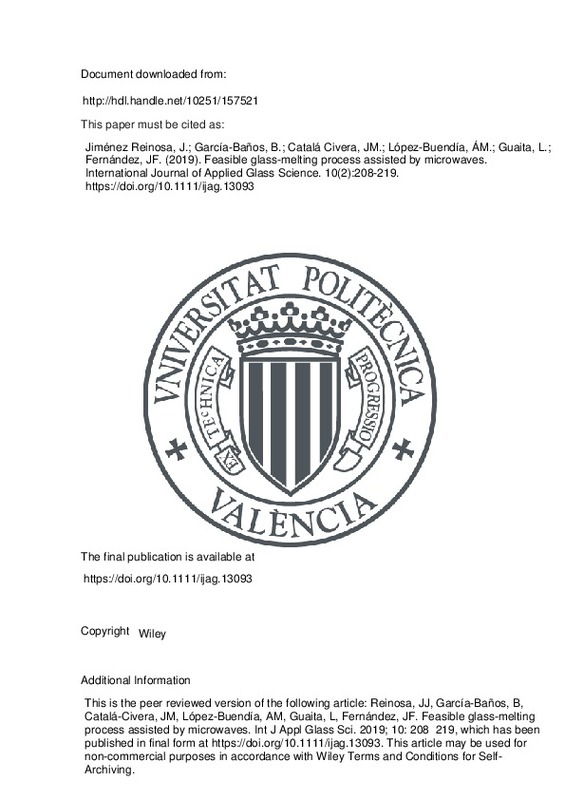Jiménez Reinosa, J.; García-Baños, B.; Catalá Civera, JM.; López-Buendía, ÁM.; Guaita, L.; Fernández, JF. (2019). Feasible glass-melting process assisted by microwaves. International Journal of Applied Glass Science. 10(2):208-219. https://doi.org/10.1111/ijag.13093
Por favor, use este identificador para citar o enlazar este ítem: http://hdl.handle.net/10251/157521
|
Título:
|
Feasible glass-melting process assisted by microwaves
|
|
Autor:
|
Jiménez Reinosa, Julian

 García-Baños, Beatriz
García-Baños, Beatriz

 Catalá Civera, José Manuel
López-Buendía, Ángel M.
Guaita, Luis
Fernández, Jose F.
Catalá Civera, José Manuel
López-Buendía, Ángel M.
Guaita, Luis
Fernández, Jose F.
|
|
Entidad UPV:
|
Universitat Politècnica de València. Departamento de Comunicaciones - Departament de Comunicacions
|
|
Fecha difusión:
|
|
|
Resumen:
|
[EN] The advantages of microwave (MW) energy processing have been verified in the sintering of a ceramic frit at a pre-industrial scale. The challenge of achieving high temperature using MW energy at such dimensions was ...[+]
[EN] The advantages of microwave (MW) energy processing have been verified in the sintering of a ceramic frit at a pre-industrial scale. The challenge of achieving high temperature using MW energy at such dimensions was overcome and a mix of natural raw materials was heated until its fluxing point. Changes in dielectric properties of the raw materials mix were also measured in situ with the increase in temperature, being in accordance to thermal processes of a conventional heating process. The properties of the resulting ceramic frit were compared with the same frit obtained by the conventional sintering method. Both frits showed similar thermal behavior regarding DTA-TGA, heating microscopy and XRD (only glassy phase was present). A Raman study confirms the existence of the mentioned glass phase. The application of the frits as glazes were performed and their properties were studied. As a result, glazes with similar properties were obtained which confirms that the MW energy processed frit is suitable for its application as a ceramic glaze.
[-]
|
|
Palabras clave:
|
Ceramic frit
,
Ceramic glaze
,
CO2 emissions
,
MW dielectric properties
,
MW energy
,
Time saving
|
|
Derechos de uso:
|
Reserva de todos los derechos
|
|
Fuente:
|
International Journal of Applied Glass Science. (issn:
2041-1286
)
|
|
DOI:
|
10.1111/ijag.13093
|
|
Editorial:
|
Wiley
|
|
Versión del editor:
|
https://doi.org/10.1111/ijag.13093
|
|
Código del Proyecto:
|
info:eu-repo/grantAgreement/EC/FP7/314636/EU/Development of adaptive ProductioN systems for Eco-efficient firing processes/
info:eu-repo/grantAgreement/AEI/Plan Estatal de Investigación Científica y Técnica y de Innovación 2013-2016/MAT2017-86450-C4-1-R/ES/DISEÑO DE PROCESOS DE SINTERIZACION EN FRIO PARA NUEVOS MATERIALES NANOESTRUCTURADOS./
info:eu-repo/grantAgreement/CSIC//201560E068/ES/Nanoestructuras funcionales en micropartículas y materiales de interés industrial (NANOMIND)/
|
|
Descripción:
|
This is the peer reviewed version of the following article: Reinosa, JJ, García-Baños, B, Catalá-Civera, JM, López-Buendía, AM, Guaita, L, Fernández, JF. Feasible glass-melting process assisted by microwaves. Int J Appl Glass Sci. 2019; 10: 208 219, which has been published in final form at https://doi.org/10.1111/ijag.13093. This article may be used for non-commercial purposes in accordance with Wiley Terms and Conditions for Self-Archiving.
|
|
Agradecimientos:
|
Consejo Superior de Investigaciones Cientificas, Grant/Award Number: CSIC201560E068; Ministerio de Ciencia, Tecnologia e Innovacion Productiva, Grant/Award Number: MAT2017-86450-C4-1-R; Seventh Framework Programme, Daphne ...[+]
Consejo Superior de Investigaciones Cientificas, Grant/Award Number: CSIC201560E068; Ministerio de Ciencia, Tecnologia e Innovacion Productiva, Grant/Award Number: MAT2017-86450-C4-1-R; Seventh Framework Programme, Daphne Project, Grant/Award Number: 314636
[-]
|
|
Tipo:
|
Artículo
|







![[Cerrado]](/themes/UPV/images/candado.png)


